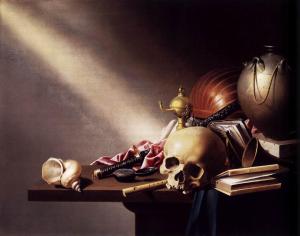The Painting:
Vanitas Stilleben by Harmen Steenwijck (1640) in Delft, Netherlands.
The whole title is “Still Life: An Allegory of the Vanities of Human Life” according to the National Gallery in London.
The interpretation:
In this painting, the books represent human knowledge, the recorder represents pleasures of the senses, the shell and samurai sword represent wealth, and the watch represents how short life is. All of these items are placed around a dominating skull which represents the end of human life (death). This painting is suppose to symbolize the temporality of life and the vanity of wealth (The National Gallery).
Inspiration:
I feel as if this painting was inspired by the rise of the merchant class. Merchants and the rich supported the arts so they could sponsor artists, whereas the Church started to make strict rules saying what could and could not be in art. The painting as a whole is a prime example of realism. Art was now more wide-spread and cheaper so it wasn’t just for the rich anymore, it was for everybody (Vermeer). Englishmen John Evelyn wrote, “pictures are very common here [in the Netherlands], there being scarce an ordinary tradesman whose house is not decorated with them.”
Deviced useds
Notice Steenwijck’s use of light. During this period, extreme uses of value (also known as chiaroscuro) were very popular in the visual arts. Still-lifes and portraits were also adopted at the time. The colors used in this selected work I would not call rich; however, when they are all composed together, the brights stand out and the darks and lights contrast each other. The objects in the painting have texture and detail.
Works Cited:
“Still Life: An Allegory of the Vanities of Human Life.” Harmen Steenwyck. The National Gallery, n.d. Web. 07 Oct. 2014.<http://www.nationalgallery.org.uk/paintings/harmen-steenwyck-still-life-an-allegory-of-the-vanities-of-human-life>
“A Brief Overview of the Dutch Art Market in the 17th Century.” A Brief Overview of the Dutch Art Market in the 17th Century. Essential Vermeer, 2014. Web. 07 Oct. 2014. <http://www.essentialvermeer.com/dutch-painters/dutch_art/ecnmcs_dtchart.html#.VDOCkSldWfs>.
